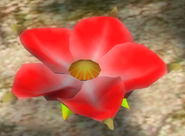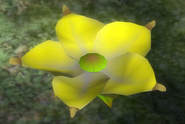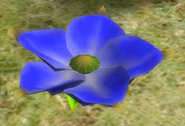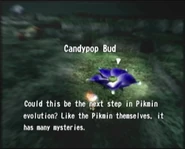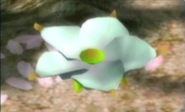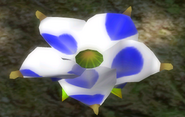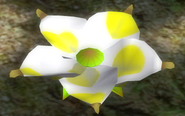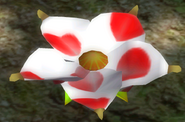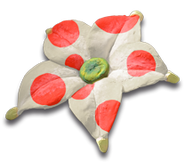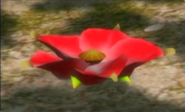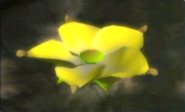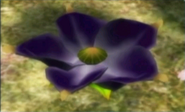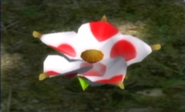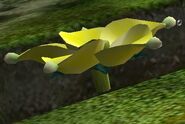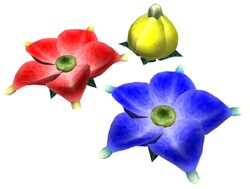
Artwork of Candypop Buds from Pikmin.
Candypop Buds are large flowers with fleshy petals and are found in all three Pikmin games. When Pikmin are tossed into these gigantic blossoms, they spit out new Pikmin seeds which match the color of their petals. In Pikmin, Candypop Buds will wither after 50 Pikmin are thrown in, but this number was reduced to 5 in the second game to keep the number of Purple Pikmin and White Pikmin, which can only be grown by using Candypop Buds, from growing too quickly. Using Pikmin of the same color as the flower will only count against this limit in Pikmin 1, although they will be reverted to leaf Pikmin and planted in the ground.
In Pikmin 3 the Candypop Buds are given a different appearance, with bulbs at the tips of their flowers as well as a large bucket-like cup in the middle of the flower, most likely as a "target" for captains to aim Pikmi; if a captain is instead thrown into the Bud, they will bounce off harmlessly. Unlike previous games, Candypop Buds will remain closed when alone, and only open when approached by a captain, and their roots remain after wilting. The Candypop Buds in this game do not have separate names or notes, only being referenced as the familial name, and thus the new species introduced have not been given their own names. They are more common in Mission Mode in this game, with the Violet and Ivory Candypop Buds originating in Pikmin 2 returning exclusively in the Mission Mode and Bingo Mode and never in the Story Mode.
Crimson Candypop Bud
Crimson Candypop Buds are red Candypop Buds found in all three Pikmin games. When non-red Pikmin are thrown in, they will change into Red Pikmin. The Crimson Candypop Bud is the only Candypop Bud to appear as a Sticker in Super Smash Bros. Brawl., adding 12 attack power to any Pikmin attack.
In Pikmin, one appears near the Analog Computer in The Forest Navel, where the player is encouraged to bring Yellow Pikmin and Blue Pikmin to collect the Ship Part and then convert them into Red Pikmin to bring it back through the Fire Jets in the area. They also appear in The Distant Spring and The Final Trial, alongside the other Candypop Bud types. In Pikmin 2 they are relatively rare, with just five appearing in the game; three in Bulblax Kingdom and two in Hole of Heroes. In Pikmin 3, five appear in the Distant Tundra and one appears in the Formidable Oak, with four more in the Formidable Oak Remix in Mission Mode.
Notes
To unlock the Piklopedia notes for a Candypop Bud, at least one Pikmin must be converted into a sprout from the corresponding type.
Olimar's Notes
"No matter what color Pikmin is tossed into the blossom of this flower, it spits out the same number of red Pikmin seeds. The Pikmin, the candy pop flowers, and the Pikmin Onions are not easily explained by current theories of the xenobotanical sciences, and thus have not yet been appropriately studied and classified."
Louie's Notes
"This spicy flower combusts upon contact with the tongue. Keep fire-retardant condiments within arm's reach!"
Nintendo Player's Guide
"Toss 5 Pikmin of any color into this flower, and it will produce five Red Pikmin sprouts."
Golden Candypop Bud
Golden Candypop Buds are yellow Candypop Buds found in all three Pikmin games. When non-Yellow Pikmin are thrown in, they will change into Yellow Pikmin. This particular Candypop Buds is the rarest kind in Pikmin 2, as only one is found, inside the Glutton's Kitchen on Sublevel 3, while it is the only Candypop Bud to never appear in Mission Mode in Pikmin 3.
In Pikmin, one Golden Candypop Bud appears in The Forest Navel near the Beady Long Legs, encouraging the player to use the high-flying Yellow Pikmin against the boss; another appears in The Distant Spring and one more appears in The Final Trial alongside the other types of Candypop Buds. In Pikmin 3 they appear only in Story Mode, with five in Distant Tundra and four in Formidable Oak.
Notes
To unlock the Piklopedia notes for a Candypop Bud, at least one Pikmin must be converted into a sprout from the corresponding type.
Olimar's Notes
"No matter what color Pikmin is tossed into the bosom of this flower, it spits out the same number of yellow Pikmin seeds. Current research has yet to produce any theories as to precisely what kind of interaction causes the Pikmin to change color to match the color of this flower's petals."
Louie's Notes
"This tart flower's acidic juices can burn a hole through a frying pan. Eating it would be unwise."
Nintendo Player's Guide
"The rare Golden Candypop Bud transforms any Pikmin type into Yellow Pikmin sprouts."
Lapis Lazuli Candypop Bud
Lapis Lazuli Candypop Buds are blue Candypop Buds found in all three Pikmin games. When non-Blue Pikmin are thrown in, they will change into Blue Pikmin. While they are one of the more common Candypop Buds in Pikmin 2 and Pikmin 3 due to the waterbased puzzles in those games, they are the rarest Candypop Buds in Pikmin, only appearing in two areas in the entire game. In Pikmin 3, the Lapis Lazuli Candypop Buds in Twilight River Remix can convert 10 Pikmin instead of 5; this is the only time in the series where one specific instance of a Candypop Bud can convert more Pikmin than others.
In Pikmin, they only appear in The Distant Spring and The Final Trial, alongside the other Candypop Bud types. In Pikmin 2, one is available in Frontier Cavern, three in Snagret Hole, and two in Hole of Heroes. In Pikmin 3 they are more plentiful, with four in Tropical Wilds and two in Formidable Oak; in the Mission Mode, two appear in Beastly Caverns, two in Twilight River Remix, and two in Beastly Caverns.
Notes
To unlock the Piklopedia notes for a Candypop Bud, at least one Pikmin must be converted into a sprout from the corresponding type.
Olimar's Notes
"No matter what color Pikmin is tossed into the bosom of this flower, it spits out the same number of blue Pikmin. This family of plant boasts soft, fleshy leaves, the sinewy tendrils of which allow the flower to open and close repeatedly over the course of a day."
Louie's Notes
"This flower's tough texture makes it unsuitable for salads, but its bright blue hue makes for a grandiose garnish!"
Nintendo Player's Guide
"This Candypop bud is a sign that water is near. It creates Blue Pikmin."
Violet Candypop Bud
Violet Candypop Buds are purple Candypop Buds found in Pikmin 2and Mission Mode in Pikmin 3. When non-Purple Pikmin are thrown in, they will change into Purple Pikmin; this is the main and only method of obtaining Purple Pikmin in any of the games, making them necessary for the completion of Pikmin 2. They are first introduced in Emergence Cave alongside the Purple Pikmin they produce.
In Pikmin 2, three Violet Candypop Buds are available in the Subterranean Complex, two are available in Frontier Cavern, one is available in Hole of Beasts, three are available in Bulblax Kingdom, one is available in Snagret Hole, one is available in Glutton's Kitchen, one is available in Shower Room, one is available in Cavern of Chaos, and two are available in Submerged Castle, where they are necessary to create Purple Pikmin in order to beat the Waterwraith. Some Violet Candypop Buds are only available if the player has less than 20 Purple Pikmin total: two in Emergence Cave, one additional in Frontier Cavern, two additional in Hole of Beasts, one in Citadel of Spiders, one additional in Glutton's Kitcehn, and one additional in Shower Room. Lastly, three Violet Candypop Buds are present in Novice Training in Challenge Mode.
In Pikmin 3, Violet Candypop Buds are limited to only Mission Mode, being present in just Thirsty Desert, and Bingo Battle, with four in Blooming Terrace.
Notes
To unlock the Piklopedia notes for a Candypop Bud, at least one Pikmin must be converted into a sprout from the corresponding type.
Olimar's Notes
"Research from our most recent expedition has confirmed the presence of candypop buds in subterranean regions. Considering the micro-ecologies this plant has been found in, one could surmise that it could be found in any cavern, regardless of geographic region. Tossing Pikmin into this flower results in the release of purple Pikmin seeds, regardless of the color of the Pikmin tossed in. This variety of candypop contains robustly odoriferous oils. If candypop flowers could be cultivated, there is no doubt that the plants would offer multifaceted benefits to the cosmetic, medical, and tourist industries."
Louie's Notes
"This convenient purple flower secretes a dark, flavorful oil that eliminates the need for salad dressing!"
Nintendo Player's Guide
"The most used Candypop Bud turns Pikmin weaklings into powerful Purples. Don't pass up an opportunity to add to your Purple population."
Ivory Candypop Bud
Ivory Candypop Buds are rare white Candypop Buds found in Pikmin 2 and Mission Mode in Pikmin 3. When non-White Pikmin are thrown in, they will change into White Pikmin; this is the main and only method of obtaining White Pikmin in any of the games, making them necessary for the completion of Pikmin 2. They are first introduced in White Flower Garden alongside the White Pikmin they produce.
In Pikmin 2, four are available in Subterranean Complex, three in Frontier Cavern, one in Bulblax Kingdom, two in Snagret Hole, one in Citadel of Spiders, one in Shower Room, one in Submerged Castle, and one in Cavern of Chaos. Some Ivory Candypop Buds are only available if the player has less than 20 White Pikmin total, including three in White Flower Garden, one additional in Bulblax Kingdom, one additional in Snagret Hole, and one additional in Shower Room. They also appear in Challenge Mode, with one appearing in The Giant's Bath.
In Pikmin 3, Ivory Candypop Buds are plentiful in Mission Mode, specifically the Collect Treasure objective as White Pikmin are useful for collecting piles of Nuggets. Three are present in Thirsty Desert, ten in Tropical Forest Remix, three in Thirsty Desert Remix, and three in Beastly Caverns. They do not appear in Bingo Mode, unlike Violet Candypop Buds.
Notes
To unlock the Piklopedia notes for a Candypop Bud, at least one Pikmin must be converted into a sprout from the corresponding type.
Olimar's Notes
"Research from our most recent expedition has confirmed the presence of candypop buds in subterranean regions. Considering the micro-ecologies this plant has been found in, one could surmise that it could be found in any cavern, regardless of geographic regions. Tossing Pikmin into this flower always produces white Pikmin seeds, regardless of the color of Pikmin tossed in. In many cases, plants with small leaves typically have limited photosynthetic capabilities, and thus must find alternate means of obtaining nutrients, with parasitic and predatory behavior being most common. The candypop could be considered one such example."
Louie's Notes
"This elusive flower spoils within seconds of picking, making it unsuitable for cooking."
Nintendo Player's Guide
"The only way to get White Pikmin on your squad is to use an Ivory Candypop Bud. One bud produces up to 5 pale sprouts."
Queen Candypop Bud
Queen Candypop Buds are Candypop Buds found in Pikmin 2, quite different from the others in the game. They appear in caves and allow the player to gain up to nine Pikmin if a single one of any color is thrown in. The flower's spots alternate between red, blue and yellow, presenting the player with an opportunity, with correct timing, to choose between receiving those coloured Pikmin. The plant withers after it has been used, but will reappear after rentering the cave.
They only appear in Caves in Pikmin 2, often after a Bosses Boss battle to allow the player to regain Pikmin they have lost, although the amount of Pikmin present cannot exceed 100.
Notes
To unlock the Piklopedia notes for a Candypop Bud, at least one Pikmin must be converted into a sprout from the corresponding type.
Olimar's Notes
"This specimen constantly changes colors. When Pikmin are thrown into it, it shoots out seeds that match the flower's coloration the moment the Pikmin landed inside of it. The number of seeds shot out is always greater than the number of Pikmin thrown in. It can be said that this is a completely baffling plant, and many mysteries remain over precisely what sort of relationship it has with the Pikmin. It would appear that the Pikmin gain all of the benefit from the relationship... Perhaps it is simply a different variety of Pikmin to begin with?"
Louie's Notes
"Eating this flower leads to spectacular, breathtaking indigestion."
Nintendo Player's Guide
"Throwing one Pikmin into a Queen Candypop Bud will let you raise the Pikmin population by as many as 8 little troopers. Its petals cycle through Pikmin-corresponding colors."
Winged Pikmin Candypop Bud
The title of this article or section is conjectural. Although this subject is based on canonical information, the actual name is pure conjecture. If an official name is discovered, please change the subject's name to the appropriate title.
Winged Pikmin Candypop Buds are Candypop Buds found only in Pikmin 3. When a Pikmin is thrown into the Candypop Bud they will be converted into a Winged Pikmin and returned to the ground to sprout again in the leaf stage. After five Pikmin have been converted to Winged Pikmin, the Candypop Bud will wither and die. They are coloured pink just as Winged Pikmin are colourized on the map screen.
Rock Pikmin Candypop Bud
The title of this article or section is conjectural. Although this subject is based on canonical information, the actual name is pure conjecture. If an official name is discovered, please change the subject's name to the appropriate title.
Rock Pikmin Candypop Buds are Candypop Buds found only in Pikmin 3. When a Pikmin is thrown into the Candypop Bud they will be converted into a Rock Pikmin and returned to the ground to sprout again in the leaf stage. After five Pikmin have been converted to Rock Pikmin, the Candypop Bud will wither and die. They are coloured grey just as Rock Pikmin are colourized on the map screen.
Family Notes
Ship's Log
"When I throw Pikmin into this flower, they are popped right back out. I have named this very peculiar bloom the Candypop Bud. It's strange... No matter what color Pikmin I throw in, the ones that pop out match the flower's color."
Mission Mode Tip
"Throw Pikmin into a Candypop Bud to turn them into sprouts that are the same color as the flower!"
Creature Montage notes
“Could this be the next stage in Pikmin evolution? Like the Pikmin themselves, it has many mysteries.”
Unused Candypop Buds
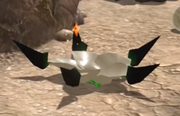
The Candypop Bud that kills Pikmin thrown into it.
In Pikmin 3, various unused Candypop Bud variants exist. One has a white colouration with long black spikes on the tips which instantly kills any Pikmin that are thrown into it. Another variation appears the same as the Crimson Candypop Bud but spits out Pikpik Carrot Pikmin instead of normal Pikmin. Neither of these variants appear finished and were likely planned for the game before being scrapped.
Gallery
Trivia
- The Creature Montage notes, alongside the aesthetic and audible characteristics shared between the Pikmin, Onions, and Candypop Buds, suggest that Candypop Buds are related to the Pikmin biologically. Olimar's Notes, however, state that this relationship still requires further exploration.
- Certain caves in Pikmin 2, such as Glutton's Kitchen and Bulblax Kingdom, contain falling Candypop Buds; if the camera is zoomed in, the roots of the Candypop Bud may be visible. This is the only way to the see the roots of the Candypop Bud without glitches or hacks before Pikmin 3.
- In Pikmin 1, Yellow Pikmin holding Bomb Rocks cannot be thrown into Candypop Buds, while in Pikmin 3, if a Pikmin holding a Bomb Rock is thrown in, the flower will take in the Bomb Rock and die, killing the Pikmin too.
- As Candypop Buds in German are called "Königinblume" (Queen flower), the Queen Candypop Bud is called "Kaiserinblume" (Empress flower).

